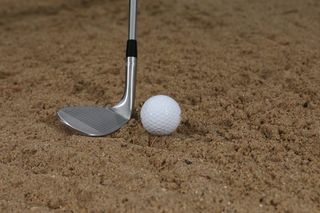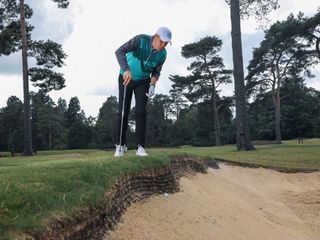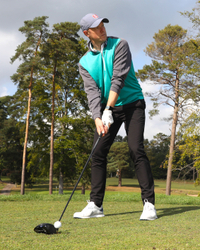Bunker Rules Every Golfer Needs To Know
Here we take a look at some of the bunker rules every golfer should know about.


Here we take a look at some of the bunker rules every golfer should know about.
Bunker Rules Every Golfer Needs To Know
In this video, Neil Tappin is joined by rules guru Jeremy Ellwood to look at the rules specifically related to bunkers. They discuss what you are and are not allowed to do to help avoid any confusion and potential penalty shots.
WATCH: Bunker Rules Every Golfer Needs To Know
The first thing we should acknowledge here is that the ball is deemed in the bunker if any part of it is actually in the bunker which should usually be defined pretty clearly. Acknowledging that, let's get to the rules...
Oh and if you are in the market for a new wedge, take a look at our guide on the best sand wedges too.
1. Not allowed to ground your club in the bunker
The main rule to follow in bunkers is you are not allowed to touch the sand with your club whether that be grounding it behind the ball, shifting sand on your backswing or having a practice shot in the sand.
Get the Golf Monthly Newsletter
Subscribe to the Golf Monthly newsletter to stay up to date with all the latest tour news, equipment news, reviews, head-to-heads and buyer’s guides from our team of experienced experts.
All of those things would be defined as testing the sand because at the end of the day, bunkers are supposed to be hazards and to be avoided. Therefore if you do hit into one, you have to show greater skill in getting your ball out.
Nor are you allowed to use your hand to test the sand either but you are allowed to shuffle your feet into the sand to give you stability as you are about to play the shot.
Related: Rules of Golf - Plugged Lie
E-Learning Tutorial - Shoot Lower Scores!
Are you interested in making lasting improvements to your golf game? <a href="https://discover.futureplc.com/golf-monthly?utm_source=golf+monthly&utm_medium=Website&utm_campaign=Match+Play+Golf+Rules+Explained" data-link-merchant="discover.futureplc.com"">Shoot Lower Scores is an online course from Golf Monthly designed to help you find power in your swing and hole more putts as well as how to avoid falling foul of the more challenging rules of golf. Whether you want to brush up your knowledge or learn something new; this <a href="https://discover.futureplc.com/golf-monthly?utm_source=golf+monthly&utm_medium=Website&utm_campaign=Match+Play+Golf+Rules+Explained" data-link-merchant="discover.futureplc.com"" data-link-merchant="discover.futureplc.com"">tutorial is perfect.

It should be noted that there are some exceptions regarding you or your club touching the sand. First you are allowed to tidy up other parts of the bunker away from where your ball is lying for care of the course purposes.
Additionally if you take two clubs into the bunker to see which one to use, once you have decided you can put the club you decided not to use on the ground too.
Also you can use the club to steady yourself if the bunker is particularly steep of precarious to get in to.
The final exception is if you leave your ball in the bunker and in a fit of anger hit the sand with your club, there is no penalty for that.
Related: 10 Golf Rules Myths
2. Loose Impediments
A loose impediment is defined as an unattached natural object and now the rules have changed in terms of how you can remove them. Previously you would not be allowed to touch those things as you would have been penalised but now you can remove loose impediments.
There are certain situations to be wary of though. Say your ball is in the face of a bunker and is being held there by a pine cone or loose impediment. If you move that pine cone, then your ball will move which will result in a penalty and you must replace the ball. Therefore the best course of action in that specific situation would be to play it as it lies.
3. Unplayable Lies
Sometimes you may find your ball in a completely unplayable area of a bunker. The options here include the usual options of going back to play the previous shot again from wherever that was, you can drop within two clubs lengths no nearer the hole or in line for a one-stroke penalty. Indeed the old rules said this drop still had to take place in the bunker but under the new rules you can take a drop back in line, outside of the bunker but that would be with a two-stroke penalty, not one.

In terms of water in a bunker, you are entitled to relief from that but you must take relief within in the bunker. If you can't then you can take maximum available relief which could mean your feet would still be in the water but your ball wouldn't be. If there is nowhere in the bunker to drop it then you would have to drop outside, under penalty.
Related: 7 Simple Golf Rules Mistakes

Location: Wishaw GC
Andy has been coaching for over 30 years and he now specialises in the short game and putting. He has worked with a collection of both male and female tour pros and he helped take Charley Hull from a ‘conditional’ LET status to five second places in her first five starts in her rookie season before then playing in the Solheim Cup. Andy helped improve her putting stats from 34.3 to 30.49 putts per round.
Teaching philosophy:
To release a player’s instinctive capability by understanding their posture, balance and brain work together to achieve a repeatable reliable method.
Greatest teacher:
Seve Ballesteros, in the early 80s, he allowed me to watch him closely whilst he was practising his short game during tournaments at The Belfry. Seve would show me what he was doing and, although communication wasn’t great, he made sure I understood what to watch out for. Timeless advice which, I didn’t appreciate it at the time, but I certainly do now.
Most common impact fault:
Closed clubface on putts causing a pulled putt result. Poor posture is invariably the cause from an ill-fitting putter. Fitting the putter to provide optimum posture and essentially allow the body to facilitate the required movement so the wrists don’t break down pre-impact.
-
 New Balance 997 SL Golf Shoe Review
New Balance 997 SL Golf Shoe ReviewNew Balance produce some extremely stylish footwear and, in this review, Matt Cradock takes their spikeless 997 SL onto the course
By Matt Cradock Published
-
 I’ve Been A Single-Figure Golfer For 30 Years. These Are The Seven Keys To Getting (And Keeping) A Low Handicap
I’ve Been A Single-Figure Golfer For 30 Years. These Are The Seven Keys To Getting (And Keeping) A Low HandicapIt takes time and it takes a bit of work, but there are key techniques and strategies you can employ to reach your golfing goals
By Fergus Bisset Published
